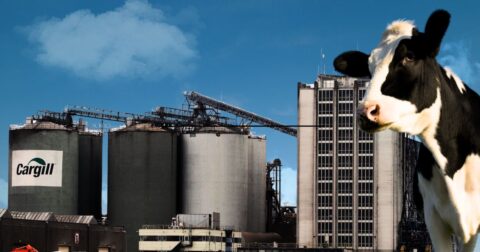News
Our Favorites Stories of 2025
Food•5 min read
Reported
This, despite commitments by the company.

This story was published in partnership with The Bureau of Investigative Journalism.
As global leaders at the UN in New York pledged to tackle human suffering caused by antimicrobial resistance, the U.S. food giant Cargill was found to be slaughtering cattle containing residues of powerful antibiotics.
Data obtained by the Bureau of Investigative Journalism (TBIJ) covering the past two years showed that farms supplying Cargill are still using antibiotics that the World Health Organization (WHO) deems vital for human health.
Two years ago, TBIJ revealed that Cargill, which sold beef to McDonalds, sourced meat from farms that used at least five critically important antibiotics. At the time, Cargill said it was “committed not to use antibiotics that are critically important for human medicines,” although it defended using other human antibiotics in farming.
This time, there were 12 different antibiotics found to be in use, including two of the most important types.
These drugs, known as “highest priority critically important” antibiotics or HP-CIAs, are so important for human health that the WHO warned livestock farmers to stop using them entirely. Use on farms can make the drugs — which are often the last treatments available for treating serious bacterial infections — less effective.
Leaders attending the high-level meeting at UN headquarters yesterday made an international declaration to cut the number of deaths caused by antibiotic resistance. The draft specifically mentions cuts in drug use on livestock farms.
Megan Brown, a sixth-generation hog and cattle farmer based in California, said that when it comes to enforcement of existing rules on antibiotic use in farming, “Historically, we’ve shown we really can’t be trusted unless we’re made to.”
Cargill said there was no evidence that beef with excessive antibiotic residues had entered the food chain, as any cattle testing at these levels would be segregated. They added that the company complied with relevant food safety standards.
In 2023, the US Department of Agriculture introduced a rule requiring a vet’s prescription before farmers could get antibiotics for their animals. However, the new rule still leaves farmers in control of how to give antibiotics, and relies on them to make sure there’s enough time between treatment and slaughter, according to Crystal Heath, a vet.
Heath is also the founder and executive director of Our Honor, a nonprofit that advocates for animal welfare. She says that intensive livestock farming has created a vicious cycle that relies on confining animals in smaller and smaller spaces. This in turn increases the risk of sickness, leading to more antibiotics being used. “This is going to be a problem for as long as we raise animals this way,” she told Sentient and TBIJ.
Daniel Czyz, a microbiologist at the University of Florida who studies antimicrobial resistance, said: “It all boils down to lowering the price of the production and increasing the profits for producers that are already struggling.”
The FDA rule was meant to minimize people’s exposure to antibiotic-resistant bacteria, which can increase the risk of superbugs spreading to people.
Antibiotic residues can linger in meat products if an animal is slaughtered too soon after being treated, before the drug has cleared its system. The U.S. government routinely investigates livestock farms that send animals for slaughter that contain drug residues, including antibiotics.
Brown, the cattle farmer, said that while some farmers still felt under pressure to send their animals on for slaughter soon after treatment, the FDA rule had changed how she used antibiotics. “I’m not going to send it to the yard until I know the withdrawal is gone,” she said.
These days, Brown uses vaccinations more often than antibiotics, which she says boosts the value of her cattle while reducing the risk of disease. The drugs, she added, are expensive.
While Brown has taken steps to reduce antibiotic residues, the US Department of Agriculture’s food safety agency recently questioned certain meat industry claims that some beef products have been raised without antibiotics.
The agency collected samples from nearly 200 cattle slaughtered at U.S. meat-packing plants and analyzed them for 180 veterinary drugs. One in five of the samples from the “raised without antibiotic” market contained antibiotic residues.
A prominent industry association continues to defend some controversial uses of antibiotics. Social media posts by the Animal Agriculture Alliance (AAA), a lobby group with links to Cargill through one of its board members, appear to endorse “preventative” antibiotics for farm animals — using the drugs on animals who are not unwell — despite concerns that this increases the risk of drug resistance. Preventative antibiotic treatment was recently restricted in the EU in 2022.
Another AAA post claims that there is “little overlap between antibiotics used in animal agriculture and antibiotics used in human medicine.” This is at odds with the views of many public health experts, including the WHO, who agree that farms’ use of antibiotics is directly contributing to drug-resistant disease in humans.
The AAA did not respond to requests for comment.
Cargill said: “Our position has been and continues to be a commitment to finding ways to reduce the use of human antibiotics across our operations and supply chains, while protecting the health and well-being of animals in our supply chains.”
“We don’t want to use antibiotics in agriculture that are clinically used for humans,” said Czyz. He warned that once a disease develops resistance to a drug, it’s difficult or impossible to reverse.
For real progress to happen, according to Czyz, there needs to be a coordinated global approach to the problem of antimicrobial resistance, as shown at the UN this week. “We cannot target [antimicrobial resistance] at one place if another place neglects the issue,” he said.